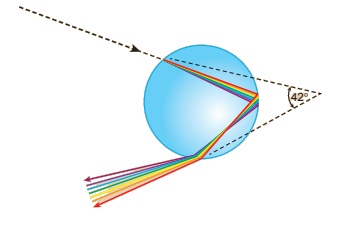Science : Chapter 3 : Light
TEXTBOOK EXERCISES
I. Choose the best answer.
1. Which of the following has curved reflecting surface?
a) plane mirrors
b) spherical mirrors
c) simple mirrors
d) None of the above
[Answer: (b) spherical mirrors]
2. The spherical mirror with a reflecting surface curved inward is called
a) convex mirror
b) concave mirror
c) curved mirror
d) None of the above
[Answer: (b) concave mirror]
3. The spherical mirror used as a rear view mirror in the vehicle is
a) concave mirror
b) convex mirror
c) plane mirror
d) None of the above
[Answer: (b) convex mirror]
4. The imaginary line passing through the centre of curvature and pole of a spherical mirror is called
a) centre of curvature
b) pole
c) principal axis
d) radius curvature
[Answer: (c) principal axis]
5. The distance from the pole to the focus is called
a) pole length
b) focal length
c) principal axis
d) None of the above
[Answer: (b) focal length]
6. If the image and object distance is same, then the object is placed at
a) infinity
b) at F
c) between f and P
d) at C
[Answer: (d) at C]
7. If the focal length of a spherical mirror is 10 cm, what is the value of its radius of curvature?
a) 10 cm
b) 5 cm
c) 20 cm
d) 15 cm
[Answer: (c) 20 cm]
II. Fill in the blanks.
1. The spherical mirror used in a beauty parlour as make-up mirror is concave mirror.
2. Geometric centre of the spherical mirror is pole.
3. Nature of the images formed by a convex mirror is smaller, virtual and erect.
4. The mirror used by the ophthalmologist to examine the eye is concave mirror.
5. If the angle of incidence is 45°, then the angle of reflection is 45°.
6. If an object is placed between two mirrors which are parallel to each other, the number of images formed is infinite.
III. Match the following.
1. Convex mirror – Radio telescopes
2. Parobolic mirror – Rear – view mirror
3. Snell’s law – Kaleidoscope
4. Dispersion of light – sin i/sin r =μ
5. Refractive index – Rainbow
[Ans : 1 – b, 2 – a, 3 – d, 4 – e 5-c]
1. Convex mirror (b) rear – view mirror
2. Parobolic mirror (a) Radio telescopes
3. Snell’s law (d) sini/sinr = μ
4. Dispersion of light (e) Rainbow
3. Refractive index
IV. Answer briefly.
1. Define focal length.
Answer: The distance between the pole and the principal focus is called focal length (f) of a spherical mirror.
2. Give any two applications of a concave and convex mirror.
Answer:
Concave mirrors :
(i) Concave mirrors are used while applying make-up or shaving, as they provide a magnified image.
(ii) They are used in torches, search lights and head lights as they direct the light to a long distance.
Convex mirrors :
(i) Convex mirrors are used in vehicles as rear view mirrors because they give an upright image and provide a wider field of view as they are curved outwards.
(ii) They are found in the hallways of various buildings including hospitals, hotels, schools and stores. They are usually mounted on a wall or ceiling where hallways make sharp turns.
3. State the laws of reflection.
Answer:
(i) The incident ray, the reflected ray and the normal at the point of incidence, all lie in the same plane.
(ii) The angle of incidence and the angle of reflection are always equal.
4. Define the refractive index of a medium.
Answer: The amount of refraction of light in a medium is denoted by a term known as refractive index of the medium, which is the ratio of the speed of light in the air to the speed of light in that particular medium.
5. State Snell’s law of refraction
Answer: Refraction of light rays, as they travel from one medium to another medium, obeys two laws, which are known as Snell’s laws of refraction. They are:
(i) The incident ray, the refracted ray and the normal at the point of intersection, all lie in the same plane.
(ii) The ratio of the sine of the angle of incidence (i) to the sine of the angle of refraction (r) is equal to the refractive index of the medium, which is a constant,
(sin i/ sin r) = μ
V. Answer in detail.
1. Explain the images formed by a concave mirror.
Answer:

2. What is reflection? Write a short note on regular and irregular reflection.
Answer: A ray of light, falling on a body having a shiny polished and smooth surface alone is bounced back. This bouncing back of the light rays as they fall on the smooth, shiny and polished surface is called reflection.
Regular reflection :
(i) When a beam of light (collection of parallel rays) falls on a smooth surface, it gets reflected.
(ii) After reflection, the reflected rays will be parallel to each other. Here, the angle of incidence and the angle of reflection of each ray will be equal.
(iii) Hence, the law of reflection is obeyed in this case and thus a clear image is formed. This reflection is called ‘regular reflection’ or ‘specular reflection’.
Irregular reflection :
(i) In the case of a body having a rough or irregular surface, each region of the surface is inclined at different angles.
(ii) When light falls on such a surface, the light rays are reflected at different angles.
(iii) In this case, the angle of incidence and the angle of reflection of each ray are not equal.
(iv) Hence, the law of reflection is not obeyed in this case and thus the image is not clear. Such a reflection is called ‘irregular reflection’ or ‘diffused reflection’.
3. Explain the working of a periscope.
Answer:
Periscope : .
(i) It is an instrument used for viewing bodies or ships, which are over and around another body or a submarine.
(ii) It is based on the principle of the law of reflection of light.
(iii) It consists of a long outer case and inside this case mirrors or prisms are kept at each end, inclined at an angle of 45°.
(iv) Light coming from the distant body, falls on the mirror at the top end of the periscope and gets reflected vertically downward.
(v) This light is reflected again by the second mirror kept at the bottom, so as to travel horizontally and reach the eye of the observer.
(vi) In some complex periscopes, optic fibre is used instead of mirrors for obtaining a higher resolution.
(vii) The distance between the mirrors also varies depending on the purpose of using the periscope.
4. What is dispersion? Explain in detail.
Answer:
(i) Splitting of white light into its seven constituent colours (wavelength), on passing through a transparent medium is known as dispersion of light.
(ii) Dispersion occurs because, light of different colours present in white light have different wavelength and they travel at different speeds in a medium.
(iii) Refraction of a light ray in a medium depends on its speed.
(iv) As each coloured light has a different speed, the constituent coloured lights are refracted at different extents, inside the prism. Moreover, refraction of a light ray is inversely proportional to its wavelength.
VI. Numerical problems.
1. The radius of curvature of a spherical mirror is 25 cm. Find its focal length.
Answer:
Given : Radius of curvature = 25 cm
To find : f = ?
Solution : f = R/2 = 25/2
f = 12.5 cm
2. If two plane mirrors are inclined to each other at an angle of 45°, find the number of images formed.
Answer:
Given : Angle of inclination = 45o
To find : Number of images formed = [ 360o / angle ] − 1
Solution :
= [ 360o / 45o ] −1
= 8 – 1 = 7 images
3. Speed of light in air is 3 × 108 m s–1 and the refractive index of a medium is 1. 5. Find the speed of light in the medium.
Answer:
Given : Speed of light in air c = 3 × 108 ms-1
Refractive index of a medium μ = 1.5
To find : Speed of light in medium v = ?
Formula : μ= c/v
Solution : 1.5 = [ 3 × 108 ] / v
V = [3×108] / 1.5
v = 2 × 108 ms-1
Speed of light in medium v = 2 × 108 ms-1
Numerical problems
Problem 1
The radius of curvature of a spherical mirror is 20 cm. Find its focal length.
Solution
Radius of curvature = 20 cm
Focal length (f) = Radius of curvature / 2
= R/2 = 20/2 = 10 cm
Problem 2
Focal length of a spherical mirror is 7 cm. What is its radius of curvature?
Solution
Radius of curvature (R) = 2 × Focal length
= 2 × 7 = 14 cm
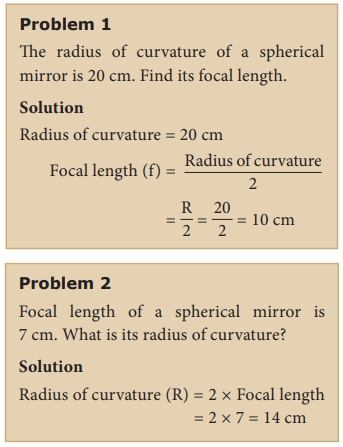
Problem 3
If two plane mirrors are inclined to each other at an angle of 90°, find the number of images formed.
Solution
Angle of inclination = 90°
Number of umber of images formed = [360°/θ] – 1
= [360°90°] –1= 4-1=3
Problem 4
Speed of light in air is 3 × 108 m s-1 and the speed of light in a medium is 2 ×108 ms-1. Find the refractive index of the medium with respect to air.
Solution
Refractive index (μ) = Speed of light in air (c) / Speed of light in the medium (v)
μ = 3×108 / 2×108 = 1.5
Problem 5
Refractive index of water is 4/3 and the refractive index of glass is 3/2. Find the refractive index of glass with respect to the refractive index of water.
Solution
wμg = Refractive index of glass / Refractive index of water
= (3/2) / (4/3) = 9/8 = 1.125
1. The radius of curvature of a spherical mirror is 25 cm. Find its focal length.
Answer:
Given : Radius of curvature = 25 cm
To find : f = ?
Solution : f = R/2 = 25/2
f = 12.5 cm
2. If two plane mirrors are inclined to each other at an angle of 45°, find the number of images formed.
Answer:
Given : Angle of inclination = 45o
To find : Number of images formed = [ 360o / angle ] − 1
Solution :
= [ 360o / 45o ] −1
= 8 – 1 = 7 images
3. Speed of light in air is 3 × 108 m s–1 and the refractive index of a medium is 1. 5. Find the speed of light in the medium.
Answer:
Given : Speed of light in air c = 3 × 108 ms-1
Refractive index of a medium μ = 1.5
To find : Speed of light in medium v = ?
Formula : μ= c/v
Solution : 1.5 = [ 3 × 108 ] / v
V = [3×108] / 1.5
v = 2 × 108 ms-1
Speed of light in medium v = 2 × 108 ms-1
Student Activities
Activity 1
Take a curved silver spoon and see the image formed by it. Now, turn it and find the image formed. Do you find any difference? Find out the reason.

Answer:
Reason :
(i) The curved surface of the spoon acts as a reflecting surface. But this reflecting surface is not flat like that of a plane mirror. Thus the spoon behaves as a curved mirror.
(ii) The inner side of the spoon is referred to as the concave side whereas the back (outer) bulging side is referred to as the convex side.
(iii) You will observe that the image is (inside bowl) always real, inverted and formed on the same side of the object.
(iv) In outside bowl the image is diminished erect and virtual.
Activity 2
List out various convex and concave mirrors used in daily life.
Answer:
Concave mirrors :
(i) It is used as torch to reflect the light.
(ii) It is used in the aircraft landing at the airports to guide the aeroplanes.
(iii) In shaving mirrors to get an enlarged and erect image of face.
(iv) In front light of cars.
(v) In marine lighthouses to guide the ships and
(vi) In the solar ovens for cooking food, heating water, recharging power back ups or melting metals.
(vii) In satellite dishes, telescopes, Dentist and ENT Doctors to obtain a larger image.
(viii) In electron microscopes and magnifying glasses.
(ix) In visual bomb detectors,
(x) In flash light mirror of camera.
Convex mirrors :
(i) Used as side – view mirror of a car as it forms an erect and smaller image.
(ii) Suitable for convenient shop and big supermarket any other comer where need anti – thief.
(iii) In the turning off the road and parking.
(iv) In making lenses of sunglasses.
(v) In securities and used in telescopes.
(vi) Used as street light reflectors because they can spread the light over a bigger area.
(vii) Used as ceiling dome mirrors.
Activity 3
Take a plane mirror and focus the light coming from the Sun on a wall. Can you see a bright spot on the wall? How does it occur? It is because the light rays falling on the mirror are bounced onto the wall. Can you produce the same bright spot with the help of any other object having a rough surface?
Answer: (i) All the objects cannot produce the same effect as produced by the plane mirror.
(ii) A ray of light, falling on a body having a shiny, polished and smooth surface alone is bounced back.
Activity 4
Take two plane mirrors and keep them perpendicular to each other. Place an object between them. You can see the images of the object. How many images do you see in the mirrors? You can see three images. How is it possible to have three images with two mirrors?
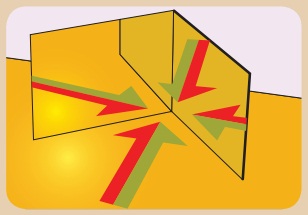
Answer:
Aim : To understand the concept multiple reflection.
Materials required : Two plane mirrors, an object.
Procedure :
(i) Take two plane mirrors and keep them perpendicular to each other.
(ii) Place an object between them.
Observation : We can see three images of the object.
Inference :
(i) When a body kept in between two plane mirrors, which were inclined to each other. You could see many images. This is because, the image formed by one mirror acts as an object for the other mirror.
(ii) The image formed by the first mirror acts as an object for the second mirror and the image formed by the second mirror acts as an object for the first mirror.
(iii) Thus we have three images of a single body. This is known as multiple reflection.
Activity 5
Take three equal sized plane mirror strips and arrange them in such a way that they form an equilateral triangle. Cover the sides of the mirrors with a chart paper. In the same manner cover the bottom of the mirrors also. Put some coloured things such as pieces of bangles and beads inside it. Now, cover the top portion with the chart paper and make a hole in it to see. You can wrap the entire piece with coloured papers to make it attractive. Now, rotate it and see through its opening. You can see the beautiful patterns.
Caution: Be careful while handling the glass pieces. Do this under the supervision of your teacher.
Answer:
Aim : To construct kaleidoscope and to produce numerous patterns of images.
Materials required : Three equal sized plane mirrors, chart paper, pieces of bangles and beads, coloured papers.
Procedure :
(i) Take three equal sized plane mirror strips and arrange them in such a way that they form an equilateral triangle.
(ii) Cover the sides of the mirrors with a chart paper.
(iii) With the help of a chart paper cover the bottom of the mirrors also.
(iv) Put some coloured things such as pieces of bangles and beads inside it.
(v) Now, cover the top portion with the chart paper and make a hole in it to see.
(vi) You can wrap the entire piece with coloured papers to make it attractive.
(vii) Now, rotate it and see through its opening. You can see the beautiful patterns.
Observation : We can see the beautiful image patterns.
Inference : Kaleidoscope is a device, which functions on the principle of multiple reflection of light to produce numerous patterns of images.
Activity 6
Take a glass beaker, fill it with water and place a pencil in it. Now, look at the pencil through the beaker. Does it appear straight? No. It will appear to be bent at the surface of the water. Why?
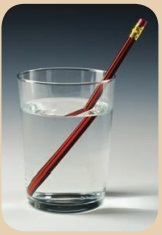
Answer:
Aim : To understand refraction of light.
Materials required : Glass beaker, water, pencil.
Procedure :
(i) Take a glass beaker.
(ii) Fill it with water
(iii) Place a pencil in it.
(iv) Now look at the pencil through the glass beaker.
(v) Does it appear straight?
Observation : It will appear to be bent at the surface of the water.
Inference :
The light rays actually travel from the water (a denser medium) into the air (a rarer medium).
(ii) When a light ray travels from a denser medium to a rarer medium, it is deviated from its straight line path.
(iii) So, the pencil appears to be bent when you see it through the glass of water.
(iv) Thus; the bending of light rays when it travels from one medium to another medium is called refraction.
Activity 7
Place a prism on a table and keep a white screen near it. Now, with the help of a torch, allow white light to pass through the prism. What do you see? You can observe that white light splits into seven colored light rays namely, violet, indigo, blue, green, yellow, orange and red (VIBGYOR) on the screen. Now, place another prism in its inverted position, between the first prism and the screen. Now, what do you observe on the screen? You can observe that white light is coming out of the second prism.
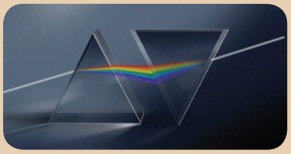
Answer:
Aim : To understand about dispersion of light.
Materials required : Prism – 2, white screen, torch light.
Procedure :
(i) Place a prism on a table and keep a white screen near it.
(ii) Now with the help of a torch, allow white light to pass through the prism. What do you see?
(Hi) Now, place another prism in its inverted position, between the first prism and the screen. What do you observe on the screen?
Observation I : We can observe that white light splits into seven coloured light rays namely, violet, indigo, blue, green, yellow, orange and red (VIBGYOR) on the screen.
Observation II : (After placing second prism)
(i) We can observe that white light is coming out of the second prism.
(ii) The first prism splits the white light into seven coloured light rays and the second prism recombines them into white light again.
Inference : It is clear that white light consists of seven colours.
Conclusion : Splitting of white light into its seven constituent colour, on passing through a transparent medium is known as dispersion of light.Method of coating a glass plate with a thin layer of reflecting metals was in practice during the 16th century in Venice, Italy. They used an amalgam of tin and mercury for this purpose. Nowadays, a thin layer of molten aluminium or silver is used for coating glass plates that will then become mirrors.Convex mirrors used invehicles as rear-view mirrorsare labeled with the safety warning: ‘Objects in the mirror are closer than they appear’. This is because inside the mirrors, vehicles will appear to becoming at a long distance.
The principle behind the working of a parabolic mirror has been known since the Greco-Roman times. The first mention of these structures was found in the book, ‘On Burning Mirrors’, written by the mathematician Diocles. They were also studied in the 10th century, by a physicist called Ibn Sahl. The first parabolic mirrors were constructed by Heinrich Hertz, a German physicist, in the form of reflector antennae in the year 1888.
Silver metal is the best reflector of light. That is why a thin layer of silver is deposited on the side of materials like plane glass sheets, to make mirrors.
The formation of rainbow is an example of dispersion of white light. This can be seen on the opposite side of the Sun. After rainfalllarge number of droplets still remain suspended in the air. When white light passes through them, it is split into seven colours. Dispersion of white light from a large number of droplets eventually forms a rainbow.
